8 books about Drone aircraft
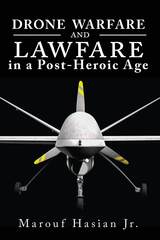
Drone Warfare and Lawfare in a Post-Heroic Age
Marouf Hasian Jr.
University of Alabama Press, 2016
In the past decade, the United States has rapidly deployed militarized drones in theaters of war for surveillance as well as targeted killing. The swiftness with which drones were created and put into service has outstripped the development of an associated framework for discussing them, with the result that basic conversations about these lethal weapons have been stymied for a lack of a shared rhetoric. Marouf Hasian’s Drone Warfare and Lawfare in a Post-Heroic Age fills that critical gap.
With a growing fleet of more than 7,500 drones, these emblems of what one commentary has dubbed “push-button, bloodless wars” comprise as much as a third of the US aircraft force. Their use is hotly debated, some championing air power that doesn’t risk the lives of pilots, others arguing that drone strikes encourage cycles of violence against the United States, its allies, and interests.
In this landmark study, Hasian illuminates both the discursive and visual argumentative strategies that drone supporters and critics both rely on. He comprehensively reviews how advocates and detractors parse and re-contextualize drone images, casualty figures, governmental “white papers,” NGO reports, documentaries, and blogs to support their points of view. He unpacks the ideological reflexes and assumptions behind these legal, ethical, and military arguments.
Visiting both formal legal language used by legislators, political leaders, and policy makers as well as public, vernacular commentaries about drones, Drone Warfare and Lawfare in a Post-Heroic Age dispassionately illuminates the emotive, cognitive, and behavioral strategies partisans use to influence public and official opinion.
With a growing fleet of more than 7,500 drones, these emblems of what one commentary has dubbed “push-button, bloodless wars” comprise as much as a third of the US aircraft force. Their use is hotly debated, some championing air power that doesn’t risk the lives of pilots, others arguing that drone strikes encourage cycles of violence against the United States, its allies, and interests.
In this landmark study, Hasian illuminates both the discursive and visual argumentative strategies that drone supporters and critics both rely on. He comprehensively reviews how advocates and detractors parse and re-contextualize drone images, casualty figures, governmental “white papers,” NGO reports, documentaries, and blogs to support their points of view. He unpacks the ideological reflexes and assumptions behind these legal, ethical, and military arguments.
Visiting both formal legal language used by legislators, political leaders, and policy makers as well as public, vernacular commentaries about drones, Drone Warfare and Lawfare in a Post-Heroic Age dispassionately illuminates the emotive, cognitive, and behavioral strategies partisans use to influence public and official opinion.
[more]
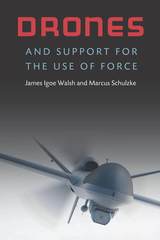
Drones and Support for the Use of Force
James Igoe Walsh and Marcus Schulzke
University of Michigan Press, 2018
Combat drones are transforming attitudes about the use of military force. Military casualties and the costs of conflict sap public support for war and for political and military leaders. Combat drones offer an unprecedented ability to reduce these costs by increasing accuracy, reducing the risks to civilians, and protecting military personnel from harm. These advantages should make drone strikes more popular than operations involving ground troops. Yet many critics believe drone warfare will make political leaders too willing to authorize wars, weakening constraints on the use of force. Because combat drones are relatively new, these arguments have been based on anecdotes, a handful of public opinion polls, or theoretical speculation.
Drones and Support for the Use of Force uses experimental research to analyze the effects of combat drones on Americans’ support for the use of force. The authors’ findings—that drones have had important but nuanced effects on support for the use of force—have implications for democratic control of military action and civil-military relations and provide insight into how the proliferation of military technologies influences foreign policy.
Drones and Support for the Use of Force uses experimental research to analyze the effects of combat drones on Americans’ support for the use of force. The authors’ findings—that drones have had important but nuanced effects on support for the use of force—have implications for democratic control of military action and civil-military relations and provide insight into how the proliferation of military technologies influences foreign policy.
[more]
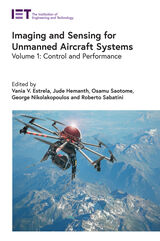
Imaging and Sensing for Unmanned Aircraft Systems
Control and Performance, Volume 1
Vania V. Estrela
The Institution of Engineering and Technology, 2020
This two-volume book set explores how sensors and computer vision technologies are used for the navigation, control, stability, reliability, guidance, fault detection, self-maintenance, strategic re-planning and reconfiguration of unmanned aircraft systems (UAS).
[more]
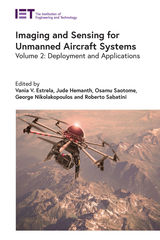
Imaging and Sensing for Unmanned Aircraft Systems
Deployment and Applications, Volume 2
Vania V. Estrela
The Institution of Engineering and Technology, 2020
This two-volume book set explores how sensors and computer vision technologies are used for the navigation, control, stability, reliability, guidance, fault detection, self-maintenance, strategic re-planning and reconfiguration of unmanned aircraft systems (UAS).
[more]
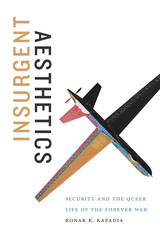
Insurgent Aesthetics
Security and the Queer Life of the Forever War
Ronak K. Kapadia
Duke University Press, 2019
In Insurgent Aesthetics Ronak K. Kapadia theorizes the world-making power of contemporary art responses to US militarism in the Greater Middle East. He traces how new forms of remote killing, torture, confinement, and surveillance have created a distinctive post-9/11 infrastructure of racialized state violence. Linking these new forms of violence to the history of American imperialism and conquest, Kapadia shows how Arab, Muslim, and South Asian diasporic multimedia artists force a reckoning with the US war on terror's violent destruction and its impacts on immigrant and refugee communities. Drawing on an eclectic range of visual, installation, and performance works, Kapadia reveals queer feminist decolonial critiques of the US security state that visualize subjugated histories of US militarism and make palpable what he terms “the sensorial life of empire.” In this way, these artists forge new aesthetic and social alliances that sustain critical opposition to the global war machine and create alternative ways of knowing and feeling beyond the forever war.
[more]

Life in the Age of Drone Warfare
Lisa Parks and Caren Kaplan, editors
Duke University Press, 2017
This volume's contributors offer a new critical language through which to explore and assess the historical, juridical, geopolitical, and cultural dimensions of drone technology and warfare. They show how drones generate particular ways of visualizing the spaces and targets of war while acting as tools to exercise state power. Essays include discussions of the legal justifications of extrajudicial killings and how US drone strikes in the Horn of Africa impact life on the ground, as well as a personal narrative of a former drone operator. The contributors also explore drone warfare in relation to sovereignty, governance, and social difference; provide accounts of the relationships between drone technologies and modes of perception and mediation; and theorize drones’ relation to biopolitics, robotics, automation, and art. Interdisciplinary and timely, Life in the Age of Drone Warfare extends the critical study of drones while expanding the public discussion of one of our era's most ubiquitous instruments of war.
Contributors. Peter Asaro, Brandon Wayne Bryant, Katherine Chandler, Jordan Crandall, Ricardo Dominguez, Derek Gregory, Inderpal Grewal, Lisa Hajjar, Caren Kaplan, Andrea Miller, Anjali Nath, Jeremy Packer, Lisa Parks, Joshua Reeves, Thomas Stubblefield, Madiha Tahir
Contributors. Peter Asaro, Brandon Wayne Bryant, Katherine Chandler, Jordan Crandall, Ricardo Dominguez, Derek Gregory, Inderpal Grewal, Lisa Hajjar, Caren Kaplan, Andrea Miller, Anjali Nath, Jeremy Packer, Lisa Parks, Joshua Reeves, Thomas Stubblefield, Madiha Tahir
[more]
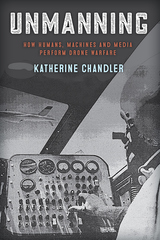
Unmanning
How Humans, Machines and Media Perform Drone Warfare
Katherine Fehr Chandler
Rutgers University Press, 2020
Unmanning studies the conditions that create unmanned platforms in the United States through a genealogy of experimental, pilotless planes flown between 1936 and 1992. Characteristics often attributed to the drone—including machine-like control, enmity and remoteness—are achieved by displacements between humans and machines that shape a mediated theater of war. Rather than primarily treating the drone as a result of the war on terror, this book examines contemporary targeted killing through a series of failed experiments to develop unmanned flight in the twentieth century. The human, machine and media parts of drone aircraft are organized to make an ostensibly not human framework for war that disavows its political underpinnings as technological advance. These experiments are tied to histories of global control, cybernetics, racism and colonialism. Drone crashes and failures call attention to the significance of human action in making technopolitics that comes to be opposed to “man” and the paradoxes at their basis.
[more]

You, Me, and the Violence
Catherine Taylor
The Ohio State University Press, 2017
“Things puppets can do to us: charm, deceive, captivate, fool, trick, remind, amuse, distract, bore, repulse, annoy, puzzle, transport, provoke, fascinate, stand in for, kill.” In You, Me, and the Violence, Catherine Taylor ponders the nature of personal and political autonomy, focusing on the surprising juxtaposition of puppetry and military drones. In a book at once politically significant and narratively engaging, Taylor blends genres to question the roles of individuals within society and expose the gritty and emotional underpinnings of the seemingly mechanical process of a remote soldier.
From conversations with her own brother about his military experiences to Punch and Judy, from the original tale of Pinocchio to the radio chatter of soldiers in active drone operation, Taylor writes about family, power, and the “theater” of war in a voice both sly and sobering, heartbreaking and hopeful.
From conversations with her own brother about his military experiences to Punch and Judy, from the original tale of Pinocchio to the radio chatter of soldiers in active drone operation, Taylor writes about family, power, and the “theater” of war in a voice both sly and sobering, heartbreaking and hopeful.
[more]
READERS
Browse our collection.
PUBLISHERS
See BiblioVault's publisher services.
STUDENT SERVICES
Files for college accessibility offices.
UChicago Accessibility Resources
home | accessibility | search | about | contact us
BiblioVault ® 2001 - 2024
The University of Chicago Press









